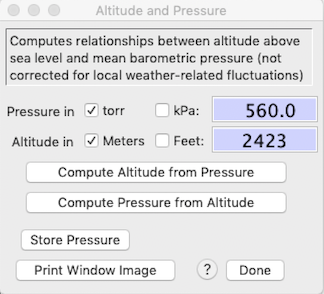|
 This option computes
an estimate of mean atmospheric pressure as a function of altitude, or vice
versa. It is based on a polynomial approximation of the International
Standard Atmosphere equation, obtained from the Smithsonian Meteorological
Tables (as a rough approximation, pressure decreases by 50% for every 5500
meter increase in altitude, or by 1.2 kilopascals for every 100 meters, at least within the troposphere). The results should be accurate within
1-2% of actual pressure or altitude, unless weather conditions are really
unusual. Nevertheless, if you use this calculator, you need to keep
a few caveats in mind: This option computes
an estimate of mean atmospheric pressure as a function of altitude, or vice
versa. It is based on a polynomial approximation of the International
Standard Atmosphere equation, obtained from the Smithsonian Meteorological
Tables (as a rough approximation, pressure decreases by 50% for every 5500
meter increase in altitude, or by 1.2 kilopascals for every 100 meters, at least within the troposphere). The results should be accurate within
1-2% of actual pressure or altitude, unless weather conditions are really
unusual. Nevertheless, if you use this calculator, you need to keep
a few caveats in mind:
- Due to approximation (and rounding errors), the algorithm is not completely
reversible (for example, the estimated pressure for an altitude of 2200
meters is 576.0 torr, but the estimated altitude for a pressure of 576.0 torr
is 2199.7 meters).
- The results are estimated mean values and do not account for
local pressure fluctuations arising from weather changes.
- The calculator cannot account for any pressure differential inside
your system. For example, if you use a positive-pressure ("push")
respirometry system, the pressure inside the plumbing -- and hence, inside
your flow meter -- will be slightly higher than atmospheric. The
opposite is true for a negative-pressure ("pull") flow arrangement.
If you want to be compulsive, you might consider using a water manometer
or some other pressure gauge to measure the pressure differential and add
that to atmospheric pressure during STP calculations. In most cases, the pressure differential will be small relative to total atmospheric pressure.
- Accuracy will decrease for altitudes above about 9000 meters (or pressures
less than about 230 torr).
- The newest versions let you use kilopascals (kPa) for pressure units,
in addition to torr.
- The 'store pressure' button will save the current value of barometric
pressure.
|

